A deer freezes in the headlights. When faced with civilization’s invention of strong lights, the animal temporarily becomes blind and confused in front of the fast-approaching car. As epitomized in the classic tale of “Bambi”, the survival of this fearful species is often in the hunters’ hands. However, there is a town in Japan where deer lost all their timidity! In Nara Deer Park, hunters are the ones who should worry about their lives! Protected by the Shinto belief system, centuries of tradition and law practice, deers in Nara Park are safe and sound. And above all – plentiful!
The coronavirus removed people from the streets and wild animals took over! But in Japan – the deer were ruling even before the pandemic!
When COVID-19 locked down the world, humans retreated to their houses, and the media started reporting on animals taking over. Fish in Venice, fallow deer in London, a puma in Santiago de Chile, jackals in Tel Aviv, coyotes in San Francisco, goats in the Welsh town of Llandudno, wild boars in Barcelona, and even a kangaroo hopping through downtown Adelaide, Australia. The coronavirus removed people from the streets, and wild animals in search of food migrated into our towns, further than ever before!
However, none of these examples compare to a deer invasion legitimated for centuries in Nara, the site of Japan’s first permanent capital! If you want to come up close to these beautiful creatures, Nara Deer Park (or Nara Koen, as the Japanese call it) should definitely enrich your future travel plans!
Nara had more attractions in the past, but one of them disappeared forever! Read more about Nara Dreamland, the amusement park that was trampled by history!
How many deer are there in Nara?
Every July, the researchers from the Nara Deer Preservation Foundation form a line and walk through the park while counting the deer. The most recent data (2019) showed that there were 1388 deer in the park. They call them sika deer, after a Japanese word for deer – Shika.
Why are there so many deer in Nara?
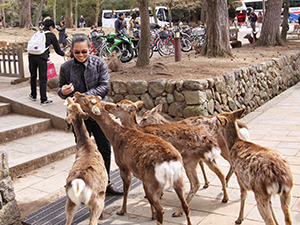
In Shinto religion, deer are considered to be sacred animals. One can trace their holy status in Nara back to the 8th century!
The legend says that Takemikazuchi, the god of thunder, traveled from Kashima Jingu to Kasuga-taisha in AD 768. This was a staggering 600-kilometer-long trip between the two temples! The god appeared on Mount Wakakusa (Mount Mikasa) riding on the back of a white deer! The deer was proclaimed a messenger of the gods.
In Nara’s history, deer had several additional magical appearances. For instance, when Kanezane, the head of the Fujiwara clan, came to supervise the rebuilding of the temple, a deer appeared in the main hall. He bowed to it, interpreting it as a sign from the gods.
The killing of these divine creatures was punishable by death until the 17th century! The offenders would be dragged around the Kofuku-ji temple, and then beheaded or stoned to death. They would also face property confiscation, and their lineage would be cut off.
Shinto religion celebrates many things Western civilization would see as unusual. If you want to check how the Japanese engage in worshipping pilgrimages in honor of a penis (!), read our article on the Kanamara Matsuri festival!
Hunger games in deer heaven
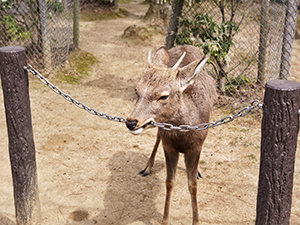
The deer numbers thrived throughout history, in thousands. Only on two occasions, they almost faced extinction. In 1873, after the Meiji Revolution, there were 38 deer in Nara! Hunger after the Second World War also took its toll! Nara deer became food, which reduced their total number to 79 in 1946.
In 1957, Nara Park deer were designated a National Natural Treasure of Japan.
Today, no one would lose their head if they were to kill a Nara deer, but you could still end up spending 10 months in jail. Facing financial problems in 2010, the restaurant owner Ginjiro Inagaki (40) thought he could elevate his menu with deer meat. He went to the park and shot a deer with a crossbow. Gods were not on his side when he faced charges in court.
In the Thai town of Lopburi, monkeys are the species locals pay respect to. See how they celebrate them during the annual Lopburi Monkey Festival!
Where are the deers in Nara?
Even though you might come across some deer in the streets of Nara (there are even traffic signs warning the drivers), your best guess is to head straight to Nara Koen or Nara Deer Park. Established in 1880, this large city park in central Nara is one of the oldest parks in Japan. It is also home to important temples such as Todai-ji, Kofuku-ji, Kasuga-taisha, as well as the Nara National Museum.
What do you feed deer in Nara?
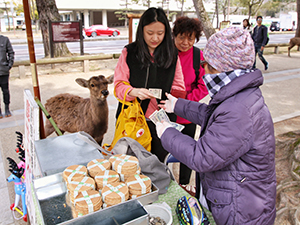
Deer in Nara are perfectly capable of finding their own food! Typically, they eat grass and leaves from the low branches of the trees. This makes Nara’s parks fairly tidy and see-through, at least to the height of 195 cm the animals can reach (the “deer line”).
But with time, the deer acquired a taste for special snacks which made them even more fearless in front of the tourists heading to Nara Deer Park!
Shika Senbei are deer crackers, available for purchase on the stands of local vendors. Their main ingredients are wheat flour and rice bran.
Typically, a package of 10 crackers costs 200 Yen (less than 2 Euros), but with a number of deer eagerly waiting for a treat, your cookies will disappear in a matter of seconds!
Incredibly, even if the cracker-carts park within their reach, the deer will not attack vendors. But once they figure out you bought some Shika Senbei, they will not leave you alone until they empty your hands!
Feeding deer in Nara – a risk for your bum and their stomach
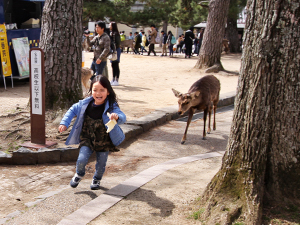
Watch out, the feeding game can become quite aggressive! The deer do not accept “no” for an answer! They are ready to kick, headbutt, bite your bum, or even knock you down until you hand over your goods!
They are very talented cracker detectors, and are capable of inspecting even your bags, purses and strollers! If you do not keep an eye on your belongings, they may devour your city maps, money, or even tickets for the temple. There is a reason behind the ticket booth display saying: “Please be careful that the deers don’t eat your ticket. It cannot be reissued and replaced.”
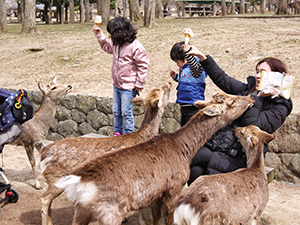
Walking around with a piece of toast or ice cream will equally draw the animals’ attention, and they will reach for your food until you give up. I’ve witnessed people feeding them with potatoes as well. But the only food you should feed deer is the official cracker, for their safety!
If you park your bicycle in front of the temple, beware of what you leave behind. As I’ve seen with my own eyes, Kleenex paper tissues and even plastic bags will disappear as soon as you say “holy cracker”! And some of these items can be quite dangerous for the deer’s digestive system!
After they fill their stomachs, they will rest in the grass and leave their feeding spot to others of their kind. Some will even floss after their meal. Or at least that’s how I interpreted the deer practice of chewing on a chain fence!
Why do deers in Nara bow?
The deer in Nara could be a one-trick pony! To get the food, this always-hungry creature will bow in front of you!
From the Fujiwara clan nobles bowing in the 9th century to the training given by the modern tourists, deer started to connect bowing with food delivery
Now, the phenomenon of the bowing deer has a somewhat biological explanation. Bobbing their head down as if starting to feed, and then quickly jerking it back up, could be a strategy for revealing the hidden predator waiting to attack when the deer is most vulnerable.
On the other side, some explain that deer bowing is a behavior learned through the 13 centuries of reverence! From the Fujiwara clan nobles bowing in the 9th century to the training given by modern tourists, deer started to connect bowing with food delivery.
Nara deer bow is definitely an intriguing behavior. Try this ritual when you visit Nara Deer Park! Bow your head first, and the deer might respond equally. But you better have a cracker ready afterward!
Nara Park tips
Every year, dozens of people get hurt in Nara Deer Park. Of course, most of these are minor injuries, but some people did break their bones and needed stitches! To make your Nara Park visit as safe and as fun as possible, please follow these 12 golden Nara deer rules!
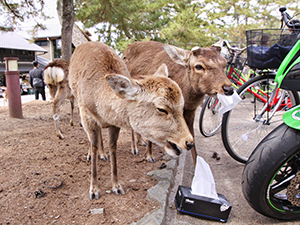
12 rules for exploring Nara Deer Park
- Wear comfortable shoes! You will walk a lot! Nara Deer Park lies on 660 hectares!
- Even if you have the most comfortable shoes in the world, do not run! Deer will chase you if they suspect you’re hiding food from them!
- Make sure all your belongings are in a safe place. Deer snouts will try to get into your bags and strollers, and you don’t want them swallowing anything of importance!
- Do not tease the deer! They have a low tolerance to jerk provocateurs!
- Feed deer only with official deer crackers! No human food is acceptable!
- Be careful if you hand crackers over to small children who could get frightened by their voracity! Parents should hold their children by hand when visiting the areas with deer!
- Do not make a long feeding spectacle! If they see you withholding or lingering with crackers, deer may attack you!
- Don’t ask for deer bowing if you have no food for a reward! Confused deer can become aggressive!
- When you have no food anymore, raise both of your hands to show they are empty. Wave “bye-bye” and the deer will usually look for the next feeder.
- Have eyes on your back! While most deer will understand you have no more food, some of them could continue being pushy and strike from behind!
- Do not try to grab the deer in order to take selfies!
- Be ready to carry your trash with you! For the reason of deer protection (unsuitable food could make them sick, and plastic waste could even kill them), there are no garbage cans in Nara Park!
What is there to do in Nara Deer Park?
Besides feeding the freely roaming deer, there are more ways to spend quality time in Nara Park. You should consider visiting its temples and art collections!
Todai-ji temple
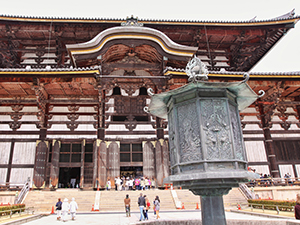
The Great Eastern Temple (Todai-ji) is one of the largest wooden buildings in the world, with a national significance in Japan! It was erected in the 8th century, and today it’s inscribed on UNESCO’s World Heritage list.
Enter through the Nandaimon Gate, where 8-meter tall figures, Nio Guardian Kings, fiercely monitor who enters the site! The octagonal bronze lantern in front of the main hall is one of the temple’s oldest treasures. But the true attraction sits inside of the Daibutsu-den! Admire the world’s largest bronze statue of Buddha, reaching 15 meters in height and about 400 tons in weight! The Great Buddha was carved in the 12th century, by the famous sculptors Unkei and Kaikei. To fully appreciate the size of the statue, check if you can squeeze through the hole in the base of the pillar at the back of the temple! It is the same size as Buddha’s nostril, and they say that those who can pass through it, will achieve enlightenment in their next life!
Kasuga-taisha shrine
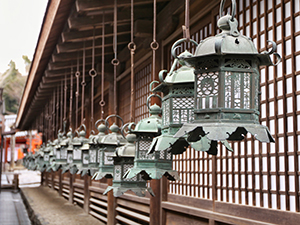
In the southern part of Nara Deer Park, also dating back to the 8th century, Kasuga-taisha is another registered World Heritage site. One approaches it through the scenic forest path, with deer occasionally protruding their heads in between the hundreds of stone lanterns. There are over 3.000 stone and bronze lanterns on the shrine grounds and they all get candle-lit twice a year: on February 3rd for Setsubun Mantoro (celebrating the transition from winter to spring), and on August 14th-15th for Chugen Mantoro (honoring the dead). In May, when the wisteria flowers bloom, this temple with white walls and vermilion columns receives a lot of visitors too. Behind the shrine, there is a sacred Kasugayama Primeval Forest, untouched for more than a millennium!
Kofuku-ji temple
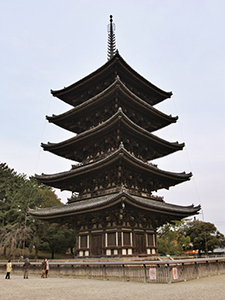
The temple of Kofuku-ji was founded in 669 in Yamashina and moved to Nara at the beginning of the 8th century. However, most of the buildings on this World Heritage Site were constructed between the 12th and 18th centuries. The most impressive is the five-story pagoda, the second tallest in Japan, reaching 50 meters in height! If you love Buddha sculptures, Kokuhokan (Kofuku-ji National Treasure Museum) has a valuable collection!
Nara National Museum
Nara National Museum (Nara Kokuritsu Hakubutsukan) is an art museum displaying Japanese Buddhist art since 1889.
Is Nara Deer Park free?
Yes, the admission to Nara Deer Park is free. However, the admission fee to The Great Buddha Hall and Todai-ji Museum is 1000 Yen (8,5 Euros). Wandering around Kofuku-ji grounds is complimentary, but entering special halls will cost you between 300 and 700 Yen. The entrance to the inner area of the Kasuga-taisha shrine costs 500 Yen. The admission to Nara National Museum is 700 Yen.
Nara Deer Park opening hours
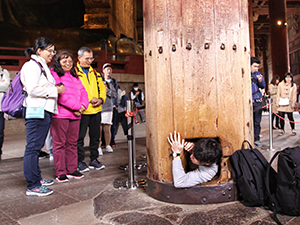
Nara Park is open 24/7.
The temples start to open between 6 and 9 am and close between 5 and 6 pm.
How to visit Nara Park?
Nara Deer Park is closest to Kintetsu Nara Station; the first area of the park is only a five-minute walk away. If you come from JR Nara Station, prepare to walk for 25 minutes.
Nara is at the foot of Mount Wakakusa, just south of Kyoto. The cities are well-connected by train, and the ride takes about an hour.
How long should you stay in Nara and where?
Nara is perfect for a day trip and you can visit major Nara Park attractions without spending the night there.
In case you want a break from bigger cities, and spend more time in the deer town, find the best available prices for Nara accommodation on this link.
With Kyoto offering a lot, you might consider staying there, as I did, in which case look for your Kyoto accommodation here.
Another option is visiting Nara from Osaka. For the best accommodation in Osaka, check this link.
When to visit Nara Park?
As for seeing deer, they are hanging around Nara Deer Park all year long, even in winter! Some interesting dates for visiting Nara, besides the already mentioned lantern festivals, could be springtime (during the cherry blossom, Todai-ji has fantastic sakura spots), August 7th (during Todai-ji Ominugui, more than a hundred priests become alpinists and descend from the roof of the temple on the Great Buddha in order to dust the statue), October (besides the magical autumn atmosphere, this month also brings the traditional ritual of cutting the deer’s antlers, to protect other deer, people, and trees).
For additional information, please visit the Nara Park website.
Nara Deer Park – conclusion
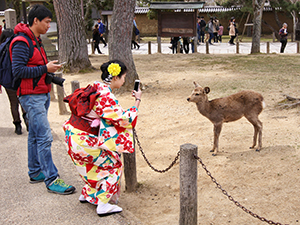
If your Japan trip brings you to the Kansai region in the south of Honshu, explore further than Kyoto or Osaka! Nara is a charming town deserving your attention, and visiting Nara Park will create lasting memories!
Deer are the symbol of the city of Nara and the national treasure of Japan! You will see their image applied as soon as you exit the train station in Japan’s original permanent capital! From manholes to vending machines, from souvenir toys to chocolate snacks shaped like deer droppings, the love for sika deer is omnipresent in Nara!
Designated as a place of scenic beauty, Nara Park is home to historical sites and temples and beautiful gardens. But large families of fawns, does, bucks and stags are its main inhabitants. Always hungry and overconfident in interaction with people, the deer approach visitors with large vitreous eyes and enormous eyelashes. Their beauty can easily trick you into believing they have manners, and their consistent poking for food surprises many visitors! Some people even fall into hysterical reactions and tantrums, propelling themselves into the stardom of funny Instagram images and YouTube videos. Google “Nara Park deer attack”, if you don’t believe me!
Just follow the rules and you will be fine! Deer are wild animals, but they behave strangely only when we confuse them with inexplicable reactions!
You have no alibi to ignore the safety warnings! They are everywhere around you! The one I liked the most was displayed in the Kofuku-ji temple. It said: “Please do not feed the pigeons!”
I hope this guide helped you plan your Nara Park itinerary. If you liked it, pin it for later!
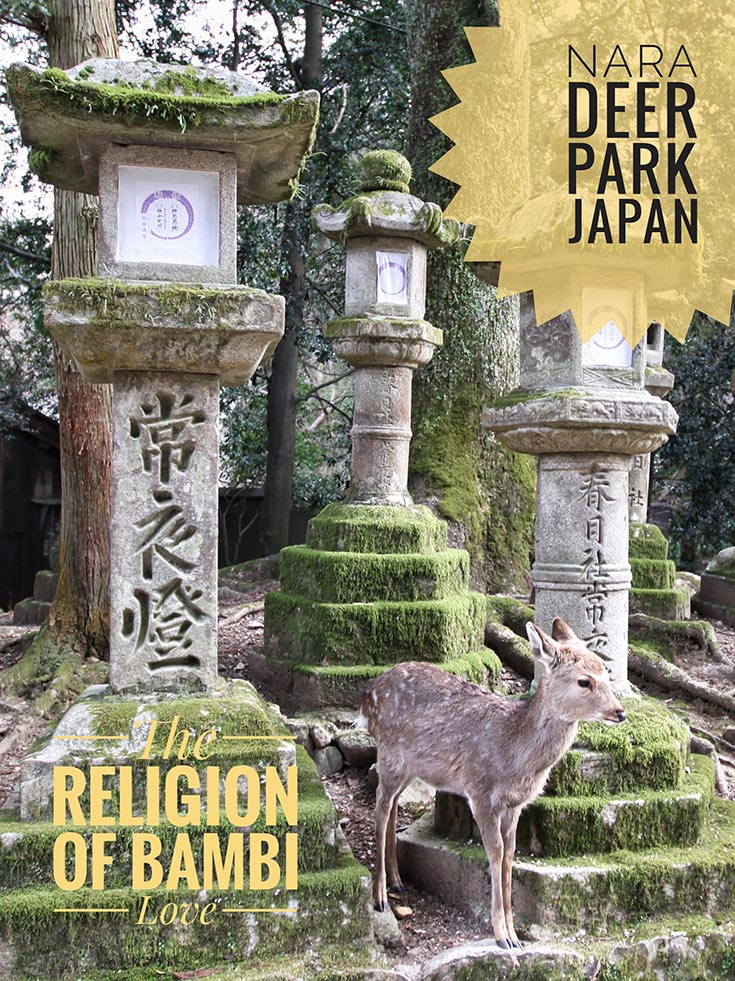
Disclosure: This post contains affiliate links, which means if you click on them and make a purchase, Pipeaway might make a small commission, at no additional cost to you. Thank you for supporting our work!

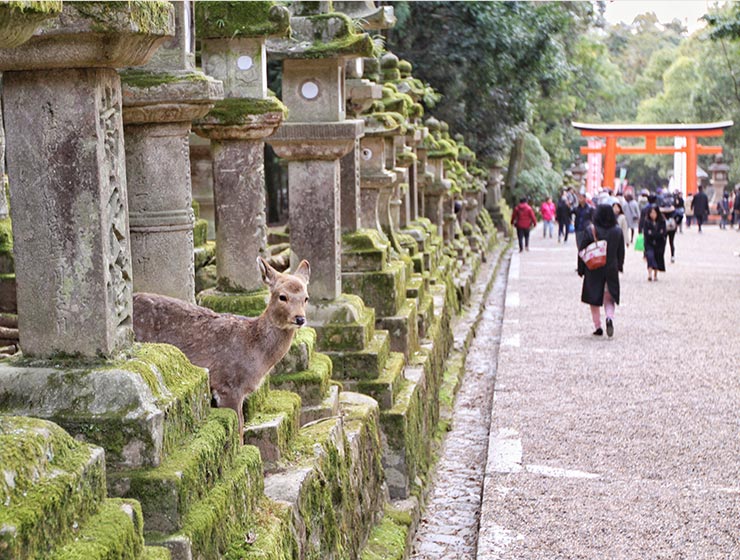

So interesting! The deer look cute, but I’m not surprised they can get pushy if they’re hungry and you’ve got food.
Who’d blame them?
At least there’s no sugar in these crackers, so they do not need to compete with humans eating the same snacks 🙂
Wow! I had no idea this existed! It reminds me of the Monkey Forest in Ubud, Bali…except these guys are sweet and friendly and monkeys will scratch your face off and steal your smartphone!
Well… Deer sweetness changes if you refuse to give away your treats 🙂
Another great guide! Just curious, how did you get into Japan in this time of quarantine? Or have you been staying in Japan before corona?
Thanks, Elizabeth!
Yes, I was there before corona!